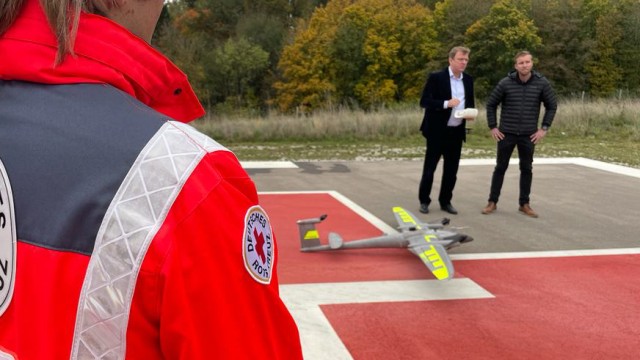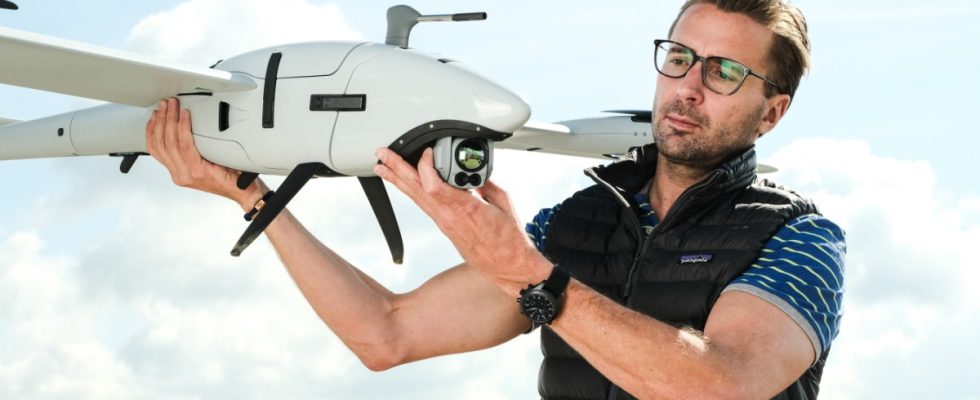Drones are now being used in more and more areas – and not just in the military context: a missile from the Gilching-based company Quantum Systems, for example, recently flew vital medicines from the Ingolstadt Clinic to Pfaffenhofen an der Ilm in a pilot project. Is this a model for the future? A conversation with qualified engineer Florian Seibel, who co-founded Quantum Systems in 2015 and is currently struggling to avoid orders. The interest in drones is not only enormous among the Federal Minister of Transport.
SZ: Mr. Seibel, these days emergency medication is usually still transported the traditional way by car. How did it come about that one of your drones has now taken on this task for the first time?
The aim of our pilot project was to see how we could organize the transport of medicines from central pharmacies to clinics to surrounding hospitals quickly and cost-effectively. We wanted to find out to what extent drones can help with this. The biggest difficulty was less the technical details than the legal hurdles.
What exactly was the problem?
There are Europe-wide regulations for the use of drones. But: their implementation within Germany is then a matter for the states. And because Germany has a federal structure, each federal state has its own authorities, some of which interpret EU regulations differently or do not process applications because they are now supposed to fulfill these additional tasks. It often depends on individual people within the aviation authorities whether a project like ours is possible or not. We were lucky, the Southern Bavaria Air Office is very progressive in this regard.
In many places, drones are considered future technologies. The Federal Ministry of Transport promotes it, but at the same time there is this patchwork of rules. Is Germany blocking itself a little?
Yes, we are slowing ourselves down with the many different requirements. Germany is actually in a good position: the technical know-how is there. The companies want. The clinics are also willing to try something like this with a view to transporting medication. And there is an economic need to explore new paths in logistics. But we have to make sure we keep pace with international competition. China is once again ahead of us in many respects. As a country, we would do well to focus more on future technologies such as drones.
The Trinity Pro from Quantum Systems flew medicines from Ingolstadt to Pfaffenhofen an der Ilm.
(Photo: Quantum Systems)
What exactly can we hope for from this?
Drones offer us enormous possibilities for the future. In addition to transporting medication, they can also be extremely helpful in matters of monitoring. I firmly believe that police helicopters can be replaced by drones in some areas. At the fire department, we are also currently working on using drones for reconnaissance as soon as an emergency call is received. This makes it possible to precisely determine how many emergency services and which device are needed on site. Statistically, this will help save lives.
And the mail? For more than ten years we have been reading about companies like Amazon wanting to deliver packages by drone. Why does the parcel courier still come?
To be honest: I don’t believe in this model at all. Amazon, for example, has already discontinued its project. As of now, it simply doesn’t make economic sense to deliver comparatively cheap products by air freight. The delivery man by car is simply much cheaper than a drone, which also requires well-trained technical staff to operate. Even if strong automation is introduced here, operating aircraft is always more complex and expensive than operating a vehicle. In addition, we as a society need to think carefully about whether we really want hundreds of thousands of drones buzzing through our cities every day. If drone logistics becomes established, it will initially be for medicines and other things that are so important that a few more euros for transport do not matter.
To get back to your project: The distance from Pfaffenhofen an der Ilm to Ingolstadt was 43 kilometers. It took your drone 38 minutes. That’s pretty slow, right?
Yes, it is definitely much faster. But for us it wasn’t about being as fast as possible. . We used an existing model from our portfolio for this. The focus was much more on things like approvals and technical details. When it comes to medication, you have to ensure the right cooling. Technically, it wouldn’t be a problem to use a drone that can fly 200 or even 300 kilometers per hour. Then you could complete the route in under ten minutes.

Departure under medical supervision: The drone with medication on board takes off from the Ingolstadt Clinic.
(Photo: BRK)
The Federal Transport Minister from the FDP wants to make Germany a “lead market” for drones and also “do everything possible” to further advance the transport of medicines using drones. Does Volker Wissing keep his word?
Unfortunately, due to our decentralized structures and the many individual state aviation authorities, Mr. Wissing’s ability to act is limited. As in many areas, federalism prevents the regulations from being implemented uniformly across the country and makes things more complicated and expensive than they should be. This does not apply to all areas. But there are some, and this includes aviation, where uniform regulations and centralization at the Federal Aviation Office would make sense. We need to address this problem first. Only then can federal policy give effective impetus to promote drones.
Nowadays, transport policy debates are always about a climate-friendly transformation of aviation. What contribution can drones make in the fight against global warming?
It would be presumptuous to say that drones save the climate. Rather, we need to ensure that we get cars off the road and jet around the world less. For me, the biggest building blocks are heating or industry. These are the problems we need to address. But aviation is also an area in which changes are needed. Drones can contribute to this because they can be used to research new basic technologies. But the idea that this will significantly reduce emissions is initially unrealistic.
Drones have long been known primarily for their destructive power. The USA has carried out numerous air strikes in Iraq and Afghanistan, which have often caused civilian casualties. Now Wissing recently declared that drones could “save lives.” How does that fit together?
Ultimately, we provide technology that can be used for different purposes. For us, it makes no difference whether our technology is used to defend Western values or to deliver medicine – at least as long as the drones themselves are not armed. This is the red line for us. But that’s the case with almost every new technology: you can use a car to save lives by transporting medicine. But you can also use it to specifically extinguish lives. As is often the case, there are two sides here too.

